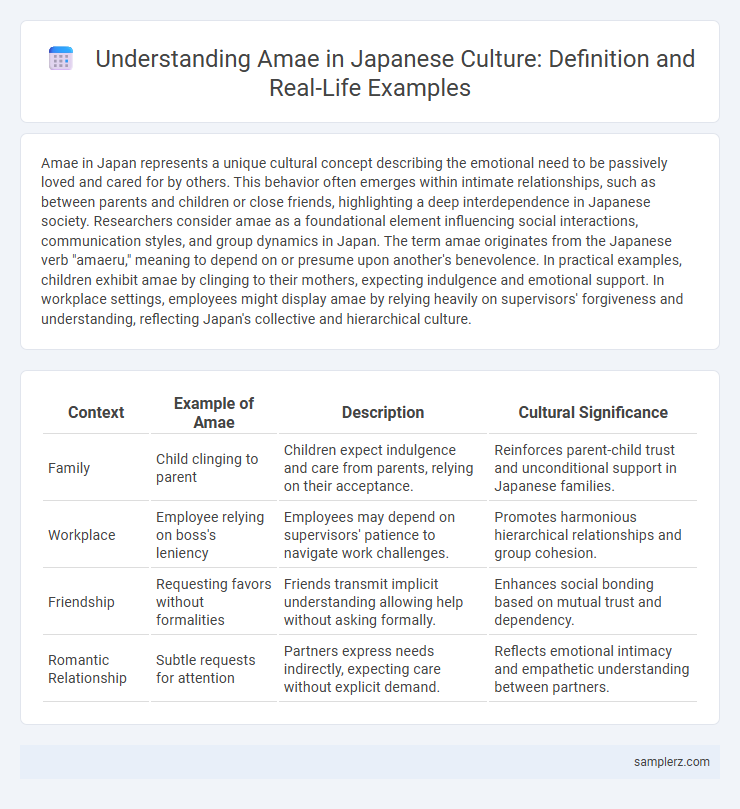Amae in Japan represents a unique cultural concept describing the emotional need to be passively loved and cared for by others. This behavior often emerges within intimate relationships, such as between parents and children or close friends, highlighting a deep interdependence in Japanese society. Researchers consider amae as a foundational element influencing social interactions, communication styles, and group dynamics in Japan. The term amae originates from the Japanese verb "amaeru," meaning to depend on or presume upon another's benevolence. In practical examples, children exhibit amae by clinging to their mothers, expecting indulgence and emotional support. In workplace settings, employees might display amae by relying heavily on supervisors' forgiveness and understanding, reflecting Japan's collective and hierarchical culture.
Table of Comparison
| Context | Example of Amae | Description | Cultural Significance |
|---|---|---|---|
| Family | Child clinging to parent | Children expect indulgence and care from parents, relying on their acceptance. | Reinforces parent-child trust and unconditional support in Japanese families. |
| Workplace | Employee relying on boss's leniency | Employees may depend on supervisors' patience to navigate work challenges. | Promotes harmonious hierarchical relationships and group cohesion. |
| Friendship | Requesting favors without formalities | Friends transmit implicit understanding allowing help without asking formally. | Enhances social bonding based on mutual trust and dependency. |
| Romantic Relationship | Subtle requests for attention | Partners express needs indirectly, expecting care without explicit demand. | Reflects emotional intimacy and empathetic understanding between partners. |
Understanding Amae: The Essence of Japanese Social Bonds
Amae, a fundamental concept in Japanese culture, epitomizes the intrinsic reliance and dependency within social relationships, emphasizing mutual trust and emotional closeness. This behavior manifests in family dynamics, where children freely express dependence on parents, and extends to workplace interactions, fostering harmonious cooperation and unspoken understanding among colleagues. Understanding amae reveals the deep-rooted cultural value placed on interconnectedness and collective harmony in Japanese society.
Amae in Japanese Family Dynamics
Amae in Japanese family dynamics represents a child's dependent behavior seeking indulgence and unconditional acceptance from parents, fostering emotional closeness and mutual trust. This cultural concept encourages interdependence, where children rely on caregivers' tolerance while parents provide warmth and understanding without strict boundaries. Amae influences communication and conflict resolution styles within families, emphasizing harmony and relational depth.
The Role of Amae in Teacher-Student Relationships
Amae in Japan plays a crucial role in teacher-student relationships by fostering mutual dependency and emotional closeness, which helps create a supportive learning environment. This cultural concept allows students to express reliance on their teachers without fear of judgment, promoting trust and cooperation. By encouraging open communication and understanding, amae strengthens educational outcomes through balanced authority and empathy.
Amae in the Japanese Workplace Culture
Amae in the Japanese workplace culture reflects employees' expectation of benevolent dependence on supervisors, fostering trust and harmonious relationships. This cultural concept encourages open communication and mutual support, enabling workers to seek guidance without fear of losing face or autonomy. Understanding amae is essential for effective management and collaboration within Japanese companies.
Childhood and Amae: Dependency in Early Years
Amae in Japan manifests prominently during childhood, where young children exhibit a natural dependence on caregivers for emotional support and comfort, reflecting cultural norms that value interdependence. This dependency fosters a secure environment in early years, allowing children to freely express vulnerability and develop trust within family dynamics. Such behavior exemplifies amae as a foundational aspect of social harmony and relational bonding in Japanese culture.
Amae Expressed through Japanese Hospitality (Omotenashi)
Amae, the deep-seated Japanese concept of seeking indulgent care, is vividly expressed through Omotenashi, the culture of wholehearted hospitality. In traditional tea ceremonies, hosts anticipate guests' needs without being asked, embodying the essence of amae by fostering a trusting, nurturing environment. This cultural practice highlights the unspoken emotional interdependence central to Japanese social interactions.
Navigating Conflict: Amae and Apology Rituals
Amae in Japan shapes conflict navigation through deeply ingrained apology rituals that emphasize humility and relational harmony. These apology practices often involve formal expressions of regret and physical gestures like bowing, reflecting an unspoken expectation of interdependence and forgiveness. The mutual acknowledgment embedded in amae fosters resolution by reinforcing social bonds and restoring group cohesion.
Amae in Romantic Relationships in Japan
Amae in Japanese romantic relationships manifests as a desire for emotional dependence and unconditional acceptance between partners, reflecting a deep-rooted cultural expectation of intimacy and trust. Partners often express amae through subtle gestures, such as asking for support during vulnerable moments or relying on each other's understanding without explicit communication. This dynamic reinforces the importance of harmonious connection and mutual caregiving within Japan's concept of love and partnership.
Literary and Media Representations of Amae
Literary and media representations of amae in Japan often depict it as a nuanced emotional dependence that shapes interpersonal relationships, illustrated vividly in works like Junichiro Tanizaki's novels and Studio Ghibli films. Characters frequently embody amae through subtle gestures or implicit trust, highlighting the cultural acceptance of vulnerability within social bonds. These portrayals deepen understanding of amae as an integral aspect of Japanese communication and emotional expression.
Modern Shifts: Amae in Contemporary Japanese Society
Amae, traditionally characterized by indulgent dependency within close relationships, is evolving in contemporary Japanese society due to increased urbanization and nuclear family structures. Modern shifts show a blend of maintaining amae in familial bonds while adapting to professional settings where independence is emphasized. Research from Waseda University highlights younger generations balancing amae with self-reliance, reflecting a nuanced cultural transformation.

example of **amae** in **Japan** Infographic
 samplerz.com
samplerz.com